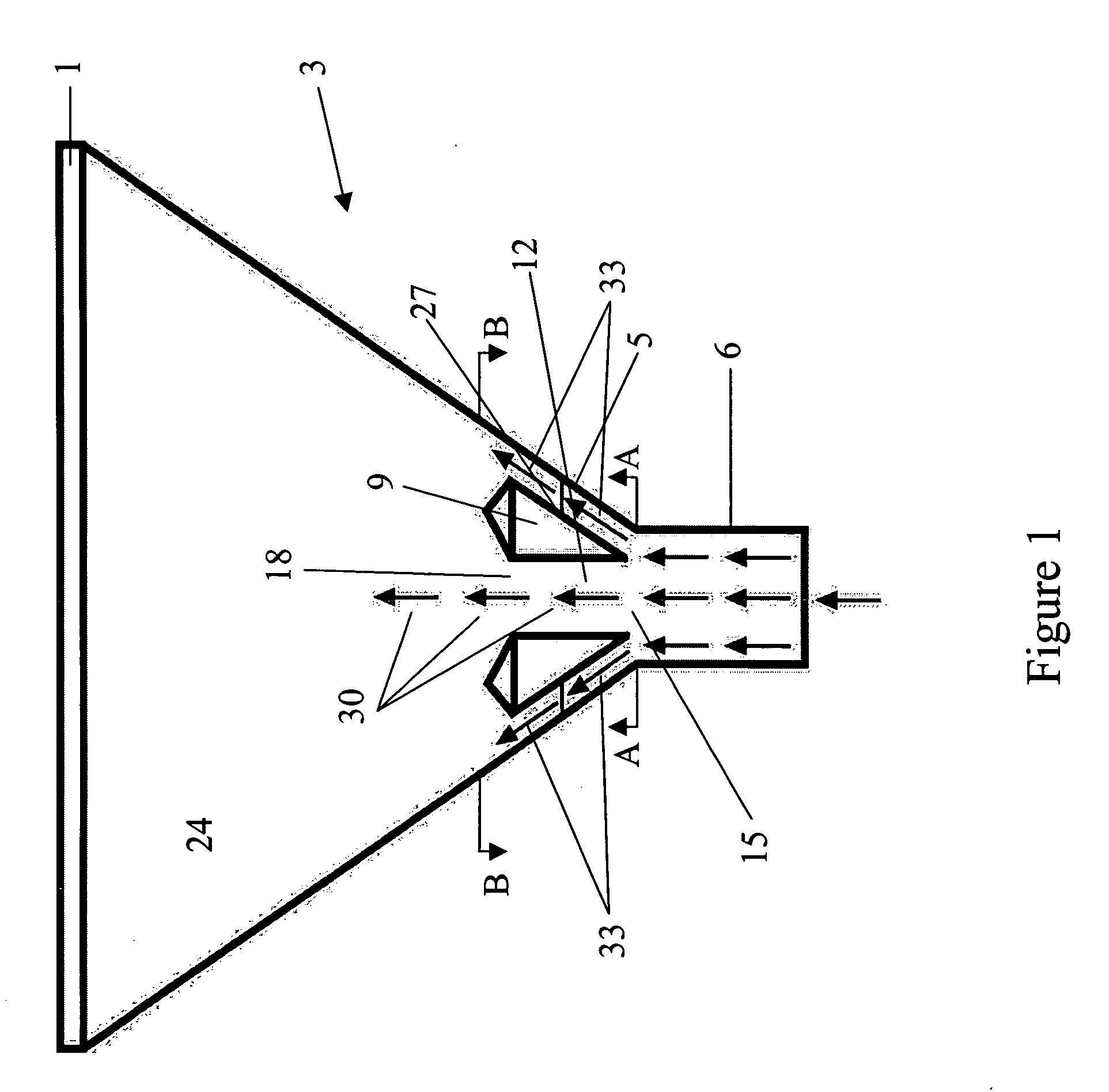Angular flow distribution bottom head
- Summary
- Abstract
- Description
- Claims
- Application Information
AI Technical Summary
Benefits of technology
Problems solved by technology
Method used
Image
Examples
example 1
Angled Annular Deflector Simulation
[0024] Using FLUENT computational fluid dynamics software, four simulations were conducted. Three of the simulations used a prior art annular disk and varied the dimensions and one simulation used the angled annular deflector design of the present invention. The simulation model tracked 100 micron particles of liquid (isopentane) which is similar to that present in condensed mode operation of a fluidized bed polymerization reactor. The fate of the 100 micron particles (i.e., whether they escaped through the distributor plate or collided with a reactor wall) was determined. FLUENT was also used to determine the wall shear stress at a point along the wall approximately 2.3 ft. above the inlet.
[0025] The first simulation used a standard fluidized bed polymerization reactor vessel with a hemispherical bottom head with an annular disk. (See U.S. Pat. No. 4,933,149). Dimensions of this bottom head design are shown in Table 1.
TABLE 1ParameterSimulatio...
example 2
Angled Annular Deflector Performance
[0029] Robust operation of a bottom head in condensed mode (where a significant portion of the recycle stream is condensate) requires that gases travel through the bottom head with sufficient momentum to carry a significant portion of liquid droplets into the fluidized bed. The fluidized bed, which is at a higher temperature than the bottom head, can vaporize the liquid. If liquid is not carried out of the bottom head, it will accumulate in a pool around the inlet, causing flow instabilities.
[0030] The ability to carry liquid out of the bottom head is reflected by the percentage of escaped particles. A larger escape percentage reflects more effective liquid transport into the fluidized bed, and therefore, the ability to operate at a higher level of condensate in the cycle gas.
[0031] Theoretically, an inlet without a flow deflector (either angular or an annular disk) will provide for the most efficient transport of liquid out of the bottom head,...
example 3
Advantages
[0035] As catalysts become more productive, it is advantageous to run higher production rates to get the most benefit out of a facility of limited size. With these higher rates come higher levels of condensing because of the greater cooling duty required for running at higher production rates. As condensate levels in the cool cycle gas increase, so does the potential to create flow instabilities at the bottom head inlet. These instabilities are caused by inefficient transfer of liquid out of the bottom head, such that the liquid forms a pool around the reactor inlet through which gas travels in discrete bubbles.
[0036] At high enough condensing levels, current technology comprising a hemispherical or elliptical bottom head and an annular disk will fail to prevent liquid pooling and consequent flow instabilities. The conical bottom head design with a parallel deflector of the present invention will prevent pooling at higher condensing levels, thus reactors can be run at hi...
PUM
| Property | Measurement | Unit |
|---|---|---|
| angle | aaaaa | aaaaa |
| velocity | aaaaa | aaaaa |
| gas velocity | aaaaa | aaaaa |
Abstract
Description
Claims
Application Information
 Login to View More
Login to View More - R&D
- Intellectual Property
- Life Sciences
- Materials
- Tech Scout
- Unparalleled Data Quality
- Higher Quality Content
- 60% Fewer Hallucinations
Browse by: Latest US Patents, China's latest patents, Technical Efficacy Thesaurus, Application Domain, Technology Topic, Popular Technical Reports.
© 2025 PatSnap. All rights reserved.Legal|Privacy policy|Modern Slavery Act Transparency Statement|Sitemap|About US| Contact US: help@patsnap.com



